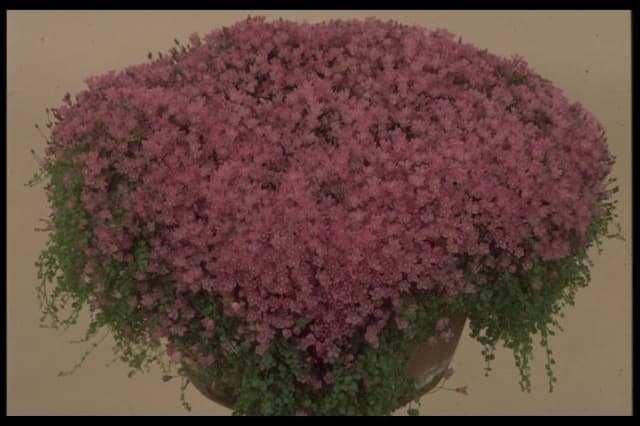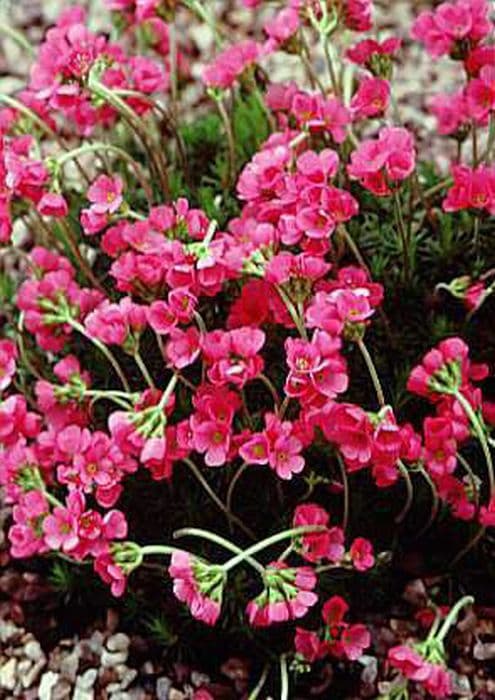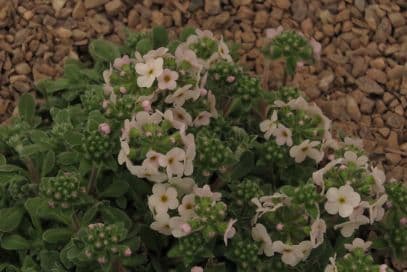Shooting Star Dodecatheon pulchellum

ABOUT
The plant commonly known as the shooting star has a unique and striking appearance that captivates the attention of many plant enthusiasts and nature observers. It features a rosette of lance-shaped, mid-green leaves from which arises a singular, upright flowering stem. This stem is adorned with numerous charming blossoms that have an intriguing reflexed shape, bending backward such that the bright petals point upwards, away from the downward-facing, yellow stamens protruding out in a conical form. The flowers of the shooting star come in a palette of colors, including shades of pink, lavender, magenta, and occasionally white. These flowers have a nodding gesture, hanging gracefully from the top of the stem, evoking the image of a meteor or star falling towards the earth—hence the name "shooting star." The visual impact of the shooting star is heightened when it is found in clusters or colonies, where its enchanting flowers can create a stunning display in the natural landscape. It should be noted that while the appearance is distinctive, the size of the shooting star (in any measurements) is not being specified here, focusing only on its visual characteristics and omitting numerical dimensions or scale.
About this plant
 Names
NamesFamily
Primulaceae.
Synonyms
Pretty Shooting Star, Dark Throat Shooting Star, Few-flowered Shooting Star, Wild Cyclamen.
Common names
Dodecatheon pulchellum var. macrocarpum, Dodecatheon pulchellum var. pulchellum, Dodecatheon pulchellum subsp. pulchellum, Dodecatheon pulchellum subsp. macrocarpum.
 Toxicity
ToxicityTo humans
Dodecatheon pulchellum, commonly known as shooting star, is not widely reported to be toxic to humans. However, as with any plant not commonly used for dietary or medicinal purposes, it is advisable to avoid ingestion due to the potential for allergic reactions or unknown toxicities. If a person ingests a part of the shooting star plant and experiences symptoms, it is recommended to seek medical attention.
To pets
Dodecatheon pulchellum, commonly known as shooting star, does not have a well-documented toxicity profile for pets. While it may not be commonly recognized as a toxic plant, it is still prudent to prevent pets from ingesting this or any non-food plant due to the possibility of gastrointestinal upset or other allergic reactions. If a pet does consume parts of the shooting star plant and shows signs of distress such as vomiting, diarrhea, or unusual behavior, contact a veterinarian.
 Characteristics
CharacteristicsLife cycle
Perennials
Foliage type
Deciduous
Color of leaves
Green
Flower color
Pink
Height
0.5-2 feet (15-61 cm)
Spread
0.5-1 feet (15-30 cm)
Plant type
Herb
Hardiness zones
3-8
Native area
North America
Benefits
 General Benefits
General Benefits- Ecosystem support – Dodecatheon pulchellum, commonly known as Shooting Star, provides nectar for early season pollinators such as bees and butterflies.
- Aesthetic appeal – With its unique and attractive downward-facing flowers, the Shooting Star is a popular choice for ornamental use in gardens and landscapes.
- Native plant appreciation – As a native wildflower, it enhances biodiversity and can stimulate interest in local flora and natural gardening practices.
- Low maintenance – Shooting Star is generally hardy and adaptable, making it suitable for gardens with minimal intervention.
- Soil erosion control – The root system of these plants helps to stabilize soil, which can be beneficial in preventing erosion in certain environments.
- Educational value – It can be used in educational settings, such as schools or botanical gardens, to teach about pollination, native species, and plant biology.
- Cultural significance – Some native plants, including Dodecatheon pulchellum, have cultural importance and can offer opportunities to connect with indigenous practices and knowledge.
 Medical Properties
Medical PropertiesThis plant is not used for medical purposes.
 Air-purifying Qualities
Air-purifying QualitiesThis plant is not specifically known for air purifying qualities.
 Other Uses
Other Uses- Dodecatheon pulchellum, commonly known as shooting star, can be used as a source of natural dye for fabrics, producing colors that vary depending on the mordant used.
- The flowers of the shooting star plant are sometimes utilized in floral arrangements to add a unique and wild aesthetic to bouquets, especially in native gardens and natural-looking designs.
- The shooting star’s nectar and pollen can be a valuable food source for early emerging insects and native bees in the garden, contributing to the biodiversity and health of the ecosystem.
- In landscaping, shooting star can be used to stabilize soil in sloped gardens due to its clumping nature, helping in the reduction of erosion.
- Enthusiasts of native plants often cultivate Dodecatheon pulchellum in wildflower meadows, contributing to the restoration and conservation of local flora.
- The shooting star's distinctive and attractive shape makes it a popular choice for botanical illustration and plant photography, often being featured in gardening books and magazines.
- Although they aren't traditionally consumed, in times of need, the leaves of shooting stars could potentially be edible when cooked to remove toxins, offering a survival food option.
- Some cultures may use the vibrant and unique appearance of shooting star blooms in symbolic ways during ceremonies or as a representation of the natural world in art.
- In education, shooting stars can be employed as a tool for teaching botany and ecology, offering a hands-on experience with native plant life cycles and pollination biology.
- Hobbyist gardeners may collect the seeds of the shooting star to participate in seed exchange programs, promoting genetic diversity and the sharing of native plants.
Interesting Facts
 Feng Shui
Feng ShuiThe Shooting Star is not used in Feng Shui practice.
 Zodiac Sign Compitability
Zodiac Sign CompitabilityThe Shooting Star is not used in astrology practice.
 Plant Symbolism
Plant Symbolism- Charm and Attraction: The Shooting Star's name and unique flower shape symbolize a sudden flash of charm and fascination, often associated with fleeting beauty or a short-lived, yet intense attraction.
- New Beginnings: As a spring bloomer, the Shooting Star represents renewal and the start of new endeavors.
- Direction and Guidance: Reflecting the flower's resemblance to a shooting star, it symbolizes direction, guidance, and the ability to follow one's path or destiny.
- Wishes and Hopes: Tying in with the concept of wishing on a shooting star, the plant signifies the idea of hope and the belief that wishes may come true.
 Water
WaterFor the Shooting Star (Dodecatheon pulchellum), water when the top inch of soil feels dry to the touch, typically once a week, but this may vary with climate and soil conditions. Gently water at the base of the plant, avoiding wetting the foliage, with approximately 1 gallon of water per watering session for an outdoor plant, ensuring even soil moisture but not waterlogging. During the dormant season in winter, reduce watering frequency to match the plant's reduced growth and water requirement.
 Light
LightShooting Stars (Dodecatheon pulchellum) thrive best in bright, indirect light or in partial shade conditions. They should be placed where they can receive filtered sunlight, such as under the canopy of taller plants or trees that provide dappled light. It's important to shield them from intense midday sun, which can scorch their leaves.
 Temperature
TemperatureShooting Stars (Dodecatheon pulchellum) prefer cool to moderate temperatures, with ideal growing conditions between 60-75°F. They can withstand occasional dips down to 20°F but should be protected from prolonged exposure to freezing temperatures. Too much heat, particularly above 80°F, can stress the plant and may warrant additional shade or water.
 Pruning
PruningFor Shooting Stars (Dodecatheon pulchellum), pruning is generally not necessary but can be done to remove spent flower stalks and dead or damaged foliage, which helps maintain plant health and appearance. Pruning is best done after the flowering period, typically in late spring or early summer, to encourage new growth for the following season.
 Cleaning
CleaningAs needed
 Soil
SoilShooting star (Dodecatheon pulchellum) prefers a well-draining, humus-rich soil mix with a pH of 6.0 to 7.0. A mix of two parts peat moss, one part perlite, and one part loamy soil will create an ideal environment for this plant. Ensure that the soil allows for adequate moisture retention while still providing good aeration for the roots.
 Repotting
RepottingShooting star should typically be repotted every 2 to 3 years. This helps to replenish the soil nutrients and provide space for the root system to grow. Repotting is best done in the early spring before new growth begins.
 Humidity & Misting
Humidity & MistingShooting star thrives in moderate to high humidity levels, ideally ranging from 50% to 70%. It is important to maintain consistent humidity but avoid overly wet conditions, which can lead to plant diseases.
 Suitable locations
Suitable locationsIndoor
Place in bright, indirect light and ensure moderate humidity.
Outdoor
Plant in dappled shade with moist, well-draining soil.
Hardiness zone
3-9 USDA
 Life cycle
Life cycleDodecatheon pulchellum, commonly known as shooting star, begins its life as a seed, often requiring a period of cold stratification to break dormancy. Upon germination in late winter or early spring, the seedling emerges, developing a rosette of oblong leaves at ground level. As the plant matures, it sends up a flowering stalk which bears the distinctive reflexed petals and protruding stamens that give shooting stars their name. After pollination, typically by bees, the flowers develop into capsules containing numerous tiny seeds. The plant then enters a period of dormancy, with leaves dying back to the ground in summer, relying on its perennial root system to survive. The shooting star completes its cycle the following year by re-sprouting from the same rootstock and repeating the process.
 Propogation
PropogationPropogation time
Spring to early summer
The most popular method of propagating Dodecatheon pulchellum, commonly known as the Shooting Star, is by seed. Seed propagation is typically undertaken in fall or early winter. The seeds require a cold period, called stratification, to break dormancy, which can be achieved by sowing them outdoors in a cold frame or in pots that are left outside through the winter to experience the natural cold conditions. Alternatively, stratification can be manually done by mixing the seeds with moist sand and refrigerating them at about 33-39 degrees Fahrenheit (1-4 degrees Celsius) for 4-6 weeks. After stratification, the seeds are sown on the surface of a well-drained seed starting mix and lightly pressed into the soil. Germination occurs when temperatures rise in the spring, and seedlings can be transplanted to their final location once they are large enough to handle and the danger of frost has passed.









